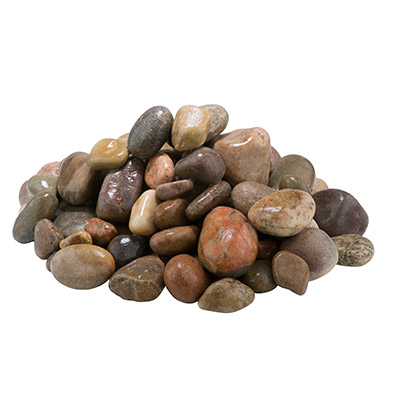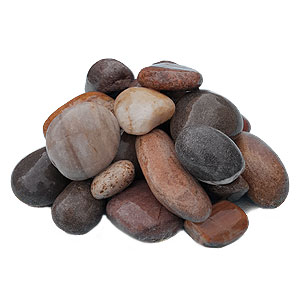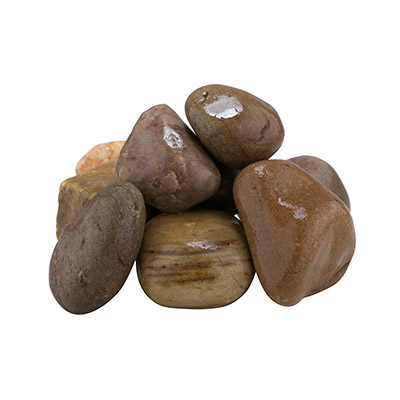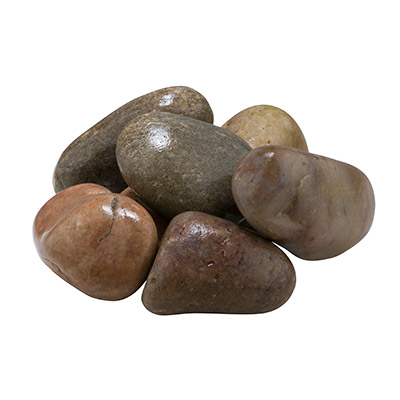Scottish pebbles and cobbles add beauty
Stones make an excellent decorative accent on soil around plants, whether they are in the ground or in pots. They also convey a fresh, clean finish to bare compost, particularly with high-quality, ornate rocks. It's best to use larger stones with curved edges like our Rustic Sage Rockery as this results in a sophisticated aesthetic, though something more rugged may be a better reflection of your style.
Whatever stones you choose, make sure they are clean and don't contain any diseases or garden pests that might be transferred to plants. Bigger stones can be cleaned with a quick hose down, while you can wash smaller stones in a bucket with a little biodegradable washing up liquid.
What other benefits can Scottish pebbles bring?
When you lay Scottish cobbles and pebbles around your plants, you get more benefits than just the aesthetics. They can actually help create a positive environment for plants to thrive - here are some of the key benefits:
1. They improve water retention
A pebble barrier at the bottom of your plant pots can be a helpful way to reduce water evaporating from the soil. Naturally, you may not want to use expensive decorative stones for this, but a pebble barrier of porous, absorbent pebbles absorbs excess water and then releases it as the soil starts to dry out. Combine this with a top dressing and your plant could experience an improvement in its water uptake.
2. They deter the flies
The battle against flies can be a constant headache for gardeners. Pebbles and cobbles can play a role in helping get this under control. The advice is to add fine sand and your chosen stones on top of the soil to prevent things like fungus gnats from laying their eggs.
With container plants in the garden, rocks can serve as heat-attracting mulch on the surface of the soil. This can be particularly helpful with plants that thrive on plenty of heat, like succulents or cacti.
3. They keep the weeds away
With rocks covering the topsoil of your plants, potted or unpotted, you can reduce the emergence of unwanted weeds. These nuisance plants can be very good at finding their way into the soil and drawing much-needed water and nutrients away from your plants, so anything that helps with controlling them is welcome.
4. They help with drainage
Placing the right types of Scottish pebbles on top of the soil can help with water drainage. If there is a lot of rain where you live, plants can end up drowning in the large amount of water they receive. Porous rocks can be added on top of the soil to absorb a lot of that rainwater. The water will then slowly drain into the soil to keep the plants getting a sensible amount of water.




Are there any disadvantages to having Scottish pebbles around plants?
There are potential drawbacks of placing stones around your plants, but they are easily averted by taking a little care. Here are the things you need to think about:
1. The issue of heating in the sun
If your plants receive a lot of sunlight throughout the day, any stones placed nearby may be heated up. As previously stated, this can be beneficial for plants that like warmth, but for other plants, it can actually cause stress. Also, with this extra heat on the top layer of soil, the evaporation rate can cause moisture loss from the soil.
This is why it's important to be aware of areas where stones would be heated by the sun. You may need to be careful about choosing the plants that grow in these areas, and you may need to water the soil more frequently to keep it moist.
2. Soil compression
If you place heavier stones around your plants, it can compress the soil underneath. This can lead to waterlogging, as compressed soil doesn't allow free drainage of water. It can also lead to less aerated soil as the particle spacing is reduced, and plants could be in jeopardy if the roots are starved of oxygen.
These issues are particularly concerning for potted plants. The best advice would be to avoid placing large, heavy stones close to plants. This way, you avoid the worry of soil compression altogether.
What about mixing rocks into the soil?
You should not be mixing rocks into the soil because this adds no benefit to the soil structure. It doesn't provide any benefit to drainage, aeration or nutrients. In fact, it will only take up space that would otherwise have been taken up by nutrient-rich soil, robbing the plant of nutrients that it could have got had the rocks not been there.
What's more, the plant roots can become entangled with the rocks, making it difficult if you ever need to move the plant. You should look at soil amendments like perlite or vermiculite if you want to improve drainage, aeration and water retention.
Conclusion
Around the world, decorative stones have become a popular feature for gardeners and landscape architects. They are aesthetically pleasing, versatile and offer many benefits to gardens. Any potential disadvantages can be easily mitigated so that the benefits vastly outweigh the risks.
If you want to protect the soil your plants rely on, Scottish pebbles and cobbles are an elegant and sophisticated solution. Browse our range of rockery stones to see what's available to you. By using them correctly, you can add an array of colours and textures to your garden whilst delivering fantastic benefits to the plants.











